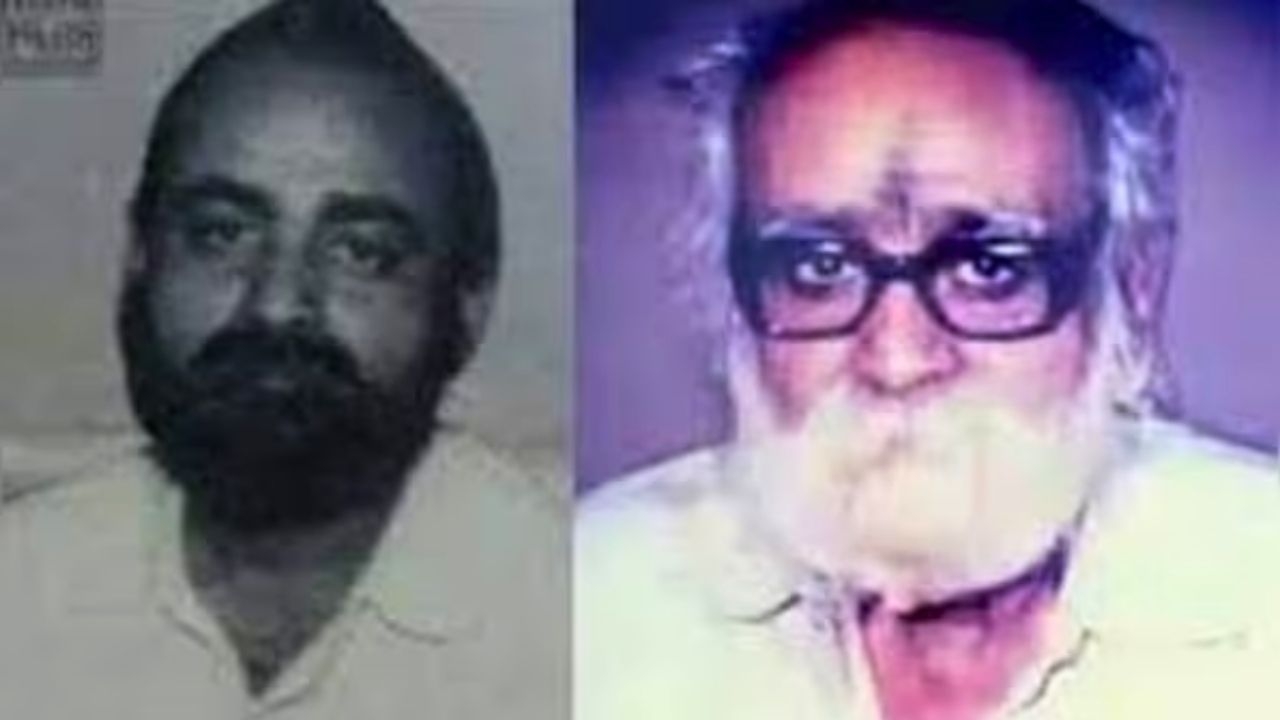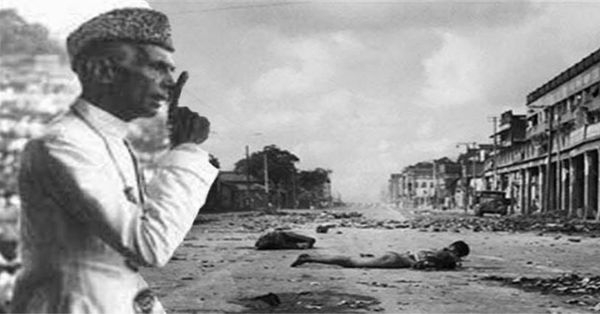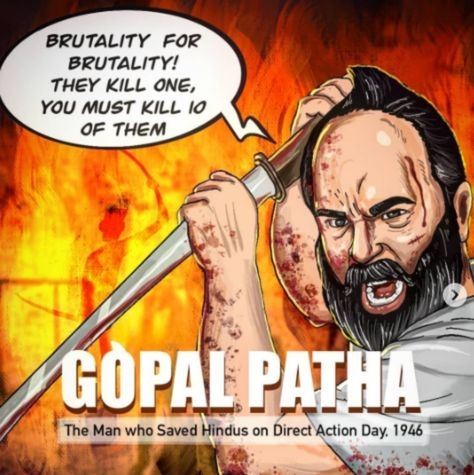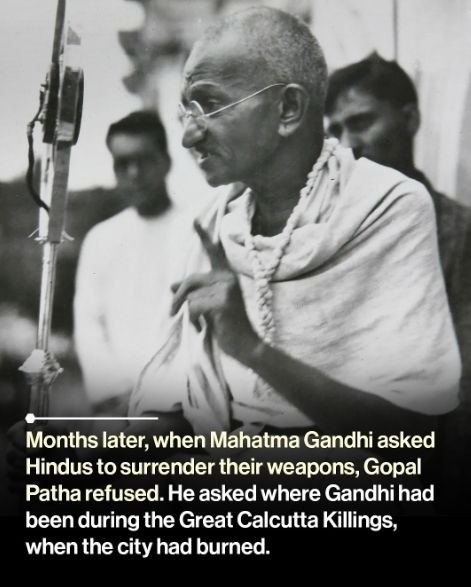The Man Who Stopped the Muslim League from Seizing Calcutta
In 1946, Gopal Patha emerged as the defender of Hindus, resisting the Muslim League’s attempts to incorporate Calcutta into Pakistan through brutal violence.
Total Views |

In 1946, a man from a meat-selling Brahmin family in the city stood up against the Muslim League's aggressive agenda to incorporate Calcutta into Pakistan.
Who was Gopal Pathak?
Gopal Chandra Mukherjee, or Gopal Patha, was born in Kolkata in 1913. ‘Patha’ means goat in Bengali, a reference to his family-run meat shop on College Street. He is often referred to as the man who saved Calcutta from falling to the Muslim League.
Gopal Chandra Mukherjee was known as ‘Gopal Patha’, as his family owned a goat-meat shop in Calcutta. Patha stands for a male goat in Bangla.
Mukherjee was a wrestler and a businessperson by profession.
Patha, one of Calcutta’s musclemen of the 1940s, rose to prominence during the 1946 riots. As violence unfolded, the 33-year-old came to be seen as the protector of the Hindu community.
“He was very ferocious,” recalled SK Bhattacharjee, a sub-inspector at Calcutta’s Lalbazar police headquarters during the Great Calcutta Killing of August 1946, as quoted in a 1997 Indian Express report by academic and journalist Andrew Whitehead.
“Gopal Patha looked like a gentleman. He was very helpful to the poor. During the riots, he came out to rescue Hindus,” Bhattacharjee added.
Gopal Patha, a member of the revolutionary group Anushilan Samiti and admirer of Netaji Subhash Chandra Bose, organised Hindu youths to counter Muslim League mobs. He reportedly armed young men to protect Hindu lives and properties.
The Direct Action Day and Gopal Patha
In 1946, the massacre of the Hindu community in Bengal was intricately planned. Jinnah is recalled as having said that he will either have India divided or India burnt and that he had given up on constitutional methods to demand the creation of Pakistan.

Jinnah had chosen the 16th of August as Direct Action Day because it was the 18th day of Ramzan, the day when the Battle of Badr was fought and won – a war fought by Prophet Muhammad himself, against the Kaffirs, and is considered to be won by Allah’s divine intervention by Muslims.
The battle led to the violent occupation of Mecca. On the 16th of August, Calcutta was littered with posters lionising Jinnah and reminding Muslims that they had to follow in the footsteps of the Prophet.
It is reported that Syed Muhammad Usman, mayor of Calcutta, had issued a widely circulated leaflet that said: 'Kafer!' Toder dhongsher aar deri nei! Sarbik hotyakando ghotbei! (Infidels! Your end is not far away! You will be massacred!).
The aim was to make Bengal ‘land of the pure’ and rid it of the Kaffirs (Hindus). The aim was to wage another Battle of Badr, in which the Muslims would conquer the heathens.
What followed on the 16th right after the Jumma Namaz was Muslims going on a rampage, beheading Hindus, chopping their limbs off and raping Hindu women. Several women were taken as sex slaves by those who were fighting with the religious fervour of the Battle of Badra.
In the Kesoram Cotton Mills at Lichubagan in the Muslim-dominated Metiabruz area, Muslim mobs entered and beheaded over 600 labourers. The Hindus, neutered and asked by Gandhi to die with a smile on their face, hardly fought back.
There was a mass exodus from Bengal that marked millions fleeing because the massacre seemed too brutal to fight against. During the Direct Action Day, on the 17th of August, after 2 days of Hindus being massacred, Gopal Chandra Mukhopadhyay rose like a phoenix.
Gopal Patha (Patha means ‘lamb’). He was called so because he ran a mutton shop and had already founded the Bharat Jatiya Bahini, an organisation of young men to help fellow citizens during a natural calamity.
On the 17th, Gopal Patha turned from a philanthropist to a warrior, ready to defend his people. Throughout the night, Gopal Patha, along with his young men from the Bharat Jayati Bahini, worked on a plan on how they could defend Hindus from the Muslim barbarians.
The Marwaris offered finances; others spent the night making weapons for them. Muslim League chief minister of Bengal, Huseyn Shaheed Suhrawardy, and the Muslim League goons had decided on the 17th that they were going to take two more days to complete the annihilation of Hindus.
But they had not taken into consideration their greatest roadblock – Gopal Patha. From the 18th to the 20th, Gopal Patha and his men put up a brave fight, paying the Muslim League goons back in equal measure, if not more.
Historian Sandip Bandopadhyay wrote, “They faced resistance everywhere. Hindu youths counter-attacked with such ferocity that the Muslim League men had to flee. Many were killed. Emboldened by their success in taking on and defeating their Islamist attackers, Hindu youths took the fight to Muslim-majority areas and started killing Islamist men. They did not, however, touch Muslim women and children or the aged and the infirm.”
‘ANSWER BRUTALITY WITH BRUTALITY.’ What Gopal Patha said on Violence and Duty

Gopal Patha organised and mobilised the gang because he believed it was the need of the hour. They equipped themselves with knives, swords, machetes, sticks, and iron rods, while Gopal carried two American pistols tucked into his waistband.
“I went round the saw mills and factories. I set an amount, sometimes Rs 1,000, sometimes Rs 5,000. They paid up. Then I declared: for one murder, you get Rs 10, for a half-murder, Rs 5. That’s how we got started,” Patha told Whitehead.
His actions were also directed at preventing Calcutta (Kolkata) being turned into a part of Pakistan by force.
“It was a very critical time for the country; the country had to be saved. If we become a part of Pakistan, we will be oppressed. So I called all my boys and said, This is the time we have to retaliate, and you have to answer brutality with brutality,” Patha was quoted as saying by academic Debjani Sengupta.
“If you come to know that one murder has taken place, you commit 10 murders. That was the order for my boys… It was basically my duty… I had to help those in distress,” Gopal Patha told the Indian Express in 1997.
GOPAL PATHA DEFIED GANDHI THRICE ON ARMS SURRENDER
A year later, when MK Gandhi visited Calcutta, still smouldering from riots and bracing for more as Bengal was gripped by the horrors of Partition, Gopal Patha refused to surrender arms despite the leader’s repeated calls.
In August 1947, when Bengal saw widespread Partition violence, Gandhi reached Calcutta and advocated disarmament to foster peace.
“People came with their weapons and placed them at the feet of Gandhiji. Shabbily dressed people came with swords, daggers and country-made guns,” journalist Sailen Chatterjee told the newspaper in 1997.
He defied calls to lay down arms thrice and even questioned Gandhi.

“Gandhi called me twice… I didn’t go. The third time, some local Congress leaders told me that I should at least deposit some of my arms… I went there. I saw people coming and depositing weapons which were of no use to anyone – out-of-order pistols, that sort of thing. Then Gandhi’s secretary said to me, ‘Gopal, why don’t you surrender your arms to Gandhiji?’ I replied, ‘With these arms I saved the women of my area; I saved the people. I will not surrender them,” Gopal Patha told the newspaper in 1997.
“Where was Gandhiji”, I said, “during the Great Calcutta Killing? Where was he then? Even if I’ve used a nail to kill someone, I won’t surrender even that nail,” he added.
Article by

Kewali Kabir Jain
Journalism Student at Makhanlal Chaturvedi National University of Journalism and Communication

